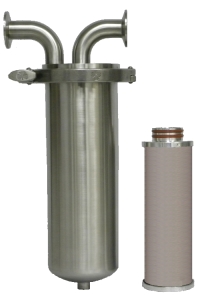Selecting and Maintaining Steam Filters for Industrial Applications
By Todd Witengier
Steam filtration is a vital part of any industrial application requiring steam as an energy source, whether it’s for driving mechanical processes, heating, or sterilization. Steam is an inherently dirty resource commonly contaminated with rust, scale and other particulates. The maintenance program for any steam-based system should always include a filtration component to protect each aspect of your system from contamination.
In industry steam is commonly used in processes for a variety of applications. Generally speaking, you can divide the industrial use of steam of its various forms into several categories, each of which exhibits specific process requirements:
- Process steam for energy transfer for such applications as thermostatic and pressure controls, or energy for driving mechanical processes;
- Culinary steam as used for food & beverage processing;
- Superheated steam is typically found in mechanical applications that rely on its considerable energy, such as electrical power production and other mechanical processes, as well as antimicrobial applications;
- Saturated steam, like superheated steam, drives mechanical processes and provides heat energy for thermostatic processes, such as cleaning and sterilization;
- Dry saturated steam processes are routinely found in pharmaceutical and petrochemical applications, as well as food and beverage processing;
- In-situ sterilization relies on steam to sterilize-in-place components of a sterile system without having to change or disassemble the system thereafter, thereby maintaining absolute sterility;
- In-situ cleaning is similar to in-situ sterilization without the absolute purification requirement.
No matter the application, there is great need for contaminant-free steam to protect downstream equipment or processes from scale, rust, and other particulates. One significant application is sterilization. By design sterile filters for compressed air or gas systems remove bacterial and viral contaminants from the compressed air source prior to application. To effectively perform this function, you must first sterilize the sterile filter and its element prior to use. Moreover, you must re-sterilize the filter every day, as well as each time you shut down the system whether for maintenance or otherwise. One effective way of sterilizing the filters in-situ is to use steam to ready the units. Introducing steam, however, also brings forth contaminants commonly found in steam sources, such as dirt, rust, and scale particulates; contaminants that will dramatically reduce the life and efficiency of the sterile filter element as its design serves to remove the aforementioned biological contaminants and not the larger coarse contaminants found in sourced steam. Steam filters will effectively remove those coarse particulates prior to the steam being introduced to the sterile filters for in-situ sterilization, thereby increasing their functional life.
Steam filter housings are necessarily manufactured of stainless steel to ensure housing integrity when operating in the rigorous environmental conditions of compressed steam sources. Lesser materials, such as aluminum or polycarbonate, are generally not suitable for steam environments. Steam filters are typically available with NPT, flange, sanitary, or stub-end connections with pipe sizes ranging from 1/2″ to 12″. Likewise, the steam filter elements are available in stainless steel combining stainless steel end caps with a porous sintered stainless steel filtration media. The sintered stainless steel element media is available in a variety of pore sizes, typically ranging from 1, 2, 5, 10, 15, 25, 40 and 50 microns, depending on your filtration requirements.
Key Factors for Sizing Filters for Your Application
When determining the proper steam filter size and its micron retention rating, you must collect specific details as they relate to your application:
- Determine the maximum allowable pore size. Keep in mind that selecting a pore size smaller than required will reduce your steam filter’s element service life, as well as create a higher pressure drop. A larger pore size than required will effectively reduce the service life and efficiency of your sterile filter installed thereafter;
- Steam flow rate of your system in either lb/hr or kg/hr;
- Steam pressure as measured psi or bar;
- Allowable pressure drop for a new/clean element as measured in psi or bar. For this specification, we recommend a pressure drop of no more than 1.0 psi or 0.07 bar, as a higher pressure drop will reduce the effective life of the steam filter element;
- Nominal Pipe Size (NPS) for the inlet and discharge of the installed filter, as well as the connection type (i.e. NPT, flange, sanitary connection, or stub-end).
Cleaning You Steam Filter Elements
Depending on contaminant type, you can safely and effectively clean your sintered stainless steel steam filter elements using a diluted hydrochloric acid solution, ultrasonic bath, water, or air. Typically, you will clean your installed steam filter element when the differential pressure reaches 15 psi or 1.0 bar. A steam filter element will have reached the end of its effective service life when the “cleaned” unit can only maintain a pressure drop that meets or exceeds 10 psi or 0.7 bar.
Whatever your system application or steam requirements, steam filters protect your equipment and downstream processes, as well as your final product in some cases, and are critical to maintain system viability and maximize performance at the lowest possible cost. Their function is invaluable, and properly selected, applied, and maintained will considerably extend the component life of downstream equipment, as well as protect your final product from unwanted contamination.
Lee Maddox is a Product Manager and filtration expert at Microdyne Products Corp.-a U.S.A. manufacturer of compressed air and gas filters. Microdyne specializes in steam filters, sterile air and gas filters, high pressure filters, coalescing filters, and our newest line of sanitary industrial filters. We service all industries that require clean compressed air and gas for their manufacturing process. Visit our website at https://microdyneproducts.com/filter-products/steam-filters/ to see our complete line of Steam Filters.
Article Source: http://EzineArticles.com/?expert=Lee_Maddox
Related Information



Sorry, the comment form is closed at this time.